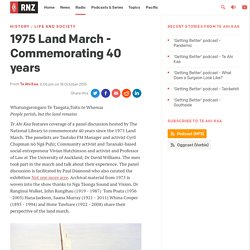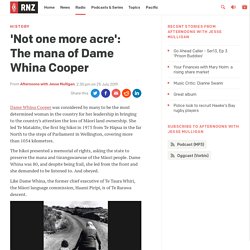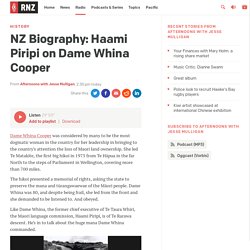Zoom
Trash

First person account of the land march. 1975 Māori Land March. 1975 Land March - Commemorating 40 years. Whatungarongaro Te Tangata,Toitu te WhenuaPeople perish, but the land remains Te Ahi Kaa features coverage of a panel discussion hosted by The National Library to commemorate 40 years since the 1975 Land March.

The panelists are Tautoko FM Manager and activist Cyril Chapman nō Ngā Puhi; Community activist and Taranaki-based social entrepreneur Vivian Hutchinson and activist and Professor of Law at The University of Auckland, Dr David Williams. The men took part in the march and talk about their experience. The panel discussion is facilitated by Paul Diamond who also curated the exhibition Not one more acre.
Archival material from 1975 is woven into the show thanks to Nga Tāonga Sound and Vision. 1975 Māori Land March. Māori Land March (1975) - Why We March. Māori Land March 1975. On 13 September 1975, around 5000 people marched from Te Hāpua in the North Island down to Wellington.

This Māori land march or hīkoi (march) led by Ngāpuhi leader Dame Whina Cooper was to protest against the loss of Māori land. On arriving in Wellington on 13 October, they presented a petition signed by 60,000 people to the Prime Minister Bill Rowling. General Websites These New Zealand websites are the best way to look for information about significant events such as the 1975 Māori Land March.
Here you can find out what happened, why it happened and who led it. Te Ara: The Encyclopedia of New Zealand Te Ara is an excellent starting point for all questions about New Zealand Aotearoa. Maori land march - 40 years on. Northern Advocate reporter Mikaela Collins writes about the historic land march led by Dame Whina Cooper, who Maori called Te Whaea o te Motu (Mother of the Nation).

The event, 40 years ago, was at the forefront of a new recognition of land rights and the need to settle grievances. Last week also marked the passing of Te Hiku Claims Settlement Bill in Parliament, Dame Whina's Te Rarawa people among the four iwi involved. The long road Te Hapua, September 14, 1975 - 80-year-old Whina Cooper steps out along a dusty Far North road with Wellington as her destination. 'Not one more acre': The mana of Dame Whina Cooper. Dame Whina Cooper was considered by many to be the most determined woman in the country for her leadership in bringing to the country's attention the loss of Māori land ownership.

She led Te Matakite, the first big hikoi in 1975 from Te Hāpua in the far North to the steps of Parliament in Wellington, covering more than 1054 kilometres. The hikoi presented a memorial of rights, asking the state to preserve the mana and tūrangawaewae of the Māori people. Dame Whina was 80, and despite being frail, she led from the front and she demanded to be listened to. And obeyed. Like Dame Whina, the former chief executive of Te Taura Whiri, the Māori language commission, Haami Piripi, is of Te Rarawa descent. Dame Whina Cooper and her grand-daughter Irenee Cooper set off on a dusty Far North road for Parliament.
Dame Whina Cooper and her grand-daughter Irenee Cooper set off on a dusty Far North road for Parliament. Addressing Te Matakite at Parliament in 1975 Photo:RNZ. NZ Biography: Haami Piripi on Dame Whina Cooper. Dame Whina Cooper was considered by many to be the most dogmatic woman in the country for her leadership in bringing to the country's attention the loss of Maori land ownership.

She led Te Matakite, the first big hikoi in 1975 from Te Hāpua in the far North to the steps of Parliament in Wellington, covering more than 700 miles. The hikoi presented a memorial of rights, asking the state to preserve the mana and tūrangawaewae of the Māori people. Dame Whina was 80, and despite being frail, she led from the front and she demanded to be listened to. And obeyed. Like Dame Whina, the former chief executive of Te Taura Whiri, the Maori language commission, Haami Piripi, is of Te Rarawa descent.
Dame Whina Cooper and her grand-daughter Irenee Cooper set off on a dusty Far North road for Parliament. Dame Whina Cooper and her grand-daughter Irenee Cooper set off on a dusty Far North road for Parliament. Maori land march sparks memories Mana article. Te ahi kaa Mana article. Race relations on the right path Mana article. Article from Maori POV : the treaty settlement framework the fiscal envelope. Kei whea te mutunga ake mo te iwi Maori : article in Te Reo. Te Hikoi the land march. Published in Waikato Times on October 18 1995 Page 3. Images related to the Māori Land Marc...